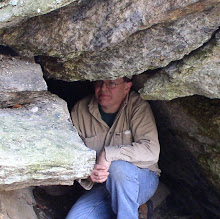With my eye on eventually ending up on the South Shore, a slight detour was made on the first day out into the Blackstone Valley. The goal was to locate Hell (cave) in Purgatory Chasm. I was successful but later on determined this is not what one explorer calls "Damnation Cave" so more to be done here. A very pleasant surprise was the location of Devil's Pulpit within the Chasm. This I missed on a previous visit although His 'Stairs' were found on that trip. But of greater interest is the old postcard of the Devil's Pulpit is not what the park once had a sign on. That sign has since disappeared.
Moving on through the Valley, my next stop was a beehive stone chamber that has finally come into the 'public domain'. Part of a Town park, this has been one of the most studied of all lithic features in New England.
Moving on into Norfolk County, three sites were next investigated. One would bring a stream access to an island containing Devil's Footprint formations. The stream, alas, was too dried up to even attempt pulling out my smaller kayak. But downstream makes a good access to the Charles River. Something for future consideration. The second stop also brought me very close to the Charles (and another dandy put in location) but to look up the old powder house on Powder House Rock. The final stop before heading to camp out on the South Shore was a small cave formation formed by the splitting of a huge mass of rock not far from the suburbs of Boston.
I returned to my more leisurely vacation mode for the second day looking over coastal locations. In particular, where kayak access might be granted. Part of that day was out at the old Scituate lighthouse. The tide was in but even the gigantic 'Pebble' could be seen sticking above the ocean surf. Later that day, I finally made use of a very small kayak access and my small boat to navigate the Gulf and one of its branches. A portage across a road, and further navigation up a very winding and ever diminishing stream, got me in close enough. Close enough to finally located the Cleft Rock from local history which I have been seeking for around ten years.
Early the next morning I dropped in on Indian Rock and the nearby old well. More tooting about the coastal areas found 'resident sticker required' to be the norm when it came to parking and accessing the ocean. But early in the afternoon found me in Hingham where smooth access was made to the Harbor. Out there were many islands to explore with a variety of rock to be seen. Farther out I could see the closer of the islands making up the Boston Harbor Park. But I chose to skirt the outer perimeter of World's End and down towards the mouth of the Weir River.
I broke camp and pulled out of the South Shore early morn on the fourth day. A bit to the north, I landed at Squantum to once again look over the rocks - and some territory that had escaped me before. After a surprise find of an old quarry and Miles Standish Monument off in the woods, I worked the rocky confines of a low tide seashore. Somewhere - likely here - the profile of Benjamin Butler once existed in the rocks. Although I would love to confirm that, I fear the very brittle argillites have disintegrated to a point where Ben may have disappeared. Another park near the beginning of Squantum lay along some giant mud flats (tide now out completely. But this small bit of territory had a rich Native American background.
Late morning finally found me back on Cape Ann. Some woods contain gigantic boulders (some small caves) were up first. After checking in to camp, I explored put in possibilities to Gloucester Harbor but eventually settled for more exploration of the Little and Annisquam Rivers.
Day five found me once again found me enjoying the site of one of my most favorite spots of all: Pigeon Cove and its rocks. But with 'work' to be done it was time to put the touring kayak into action on the ocean. Heading on down the coast, a variety of rocky areas of the coast were looked over. Shooting the Gap at Straightsmouth Island, The journey south continued passing through Whale and Loblolly Coves. Shortly before reaching Lands End, the turn was made out to sea to catch up with Thatcher Island. From there it was across to the more northerly tip of Straightsmouth Island, down its coast, through the gap again and across Sandy Bay. I wanted one more look at the Devil's Den and came away with significantly better photos than my previous visit in June. After my arrival on shore, with just a bit of time to spare, I shot on over to the old ruins of the former hospital in Rockport.
On sixth - and final day - I once again visited the rocky shore of Pigeon Cove to see the Bathtub and Swimming Place now emerged from the ocean at low tide. Then it was down to Pavilion Beach for a tour of sections of Gloucester Harbor. These included Ten Pound Island, Rocky Neck, Wonson Cove, and down past Niles Beach (Southeast Cove) towards the Eastern Point Lighthouse. An old geology publication mentioned cave formations within this area, and although the sea had 'worked' the rocks pretty good at some areas, there is nothing I would call a cave.







